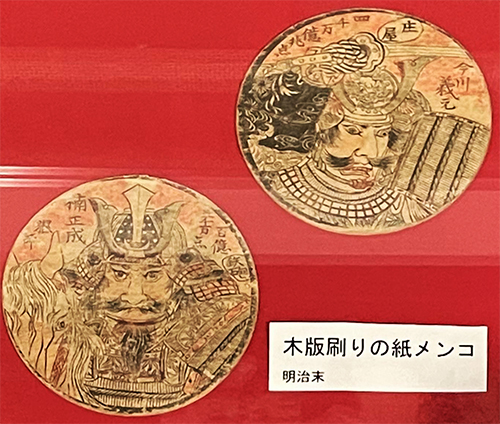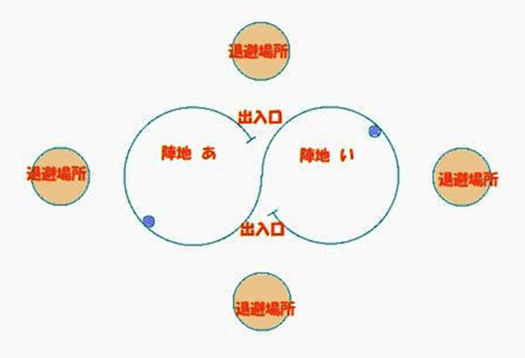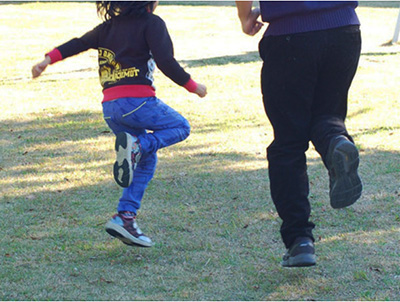


子ども遊びのDNAは相当に民族史を遡れる。メンコを調べて江戸中期にその証拠があるとされる。
そんなことを考えていてわたしの幼少年期に夢中になっていた「S陣取り」のことが無性に気に掛かるようになった。調べてみると「陣取り」という子ども遊びは古来から不変の民俗として存在したとされている。メンコの画面には「武将」の絵が描かれることが多かったけれど、江戸中期からさらに以前、たとえば尾張清洲の街遊びが大好きだったと伝承される織田信長の少年期、かれはどんな子ども遊びをしていたのだろうと想像すると、やはり「陣取り」が最初に浮かび上がってくる。
わたしの幼い頃の陣取りはS字状の陣を地面に描いて、2チームに分かれ片足ケンケンで敵陣に向かって攻めていくゲームだった。陣奥には「家宝」のコーナーがあって、そこを踏むと勝利になった。陣中に入ると両足を地面に着けて動けたが、移動中は片足ケンケン。なので移動中に敵に出会ったら、両者片足ケンケンで取っ組み合う。両足が着地したら負け。途中には休憩場所があってそこでは敵味方、平和が維持されている。

という戦争ゲームだけれど、日本民族は連綿とこの遊びを伝承してきたようだ。信長の時代にもこのような陣取りゲームは行われていただろう。あったとすれば信長の好奇心旺盛ぶりを考えれば、あらゆる勝利方程式を考えて戦っていたに違いない。また家臣団のなかにそういった幼年期以来の人物たちも多かった。現に前田利家はそのような人物像が言われる。幼少年期、毎日仮想戦争ゲームで頭の体操。虎視眈々と作戦を高度化させていたと考えるのは自然ではないか。
狭い隘路に入り込んでしまえば大軍相手でも地形を活かして勝利し得る。毎日あちこちに出没して地形を知り尽くして戦略ゲーム勘を鍛えていれば、桶狭間も可能だったのかも・・・。
どうも子ども遊びの研究発掘から歴史人物との心理の同心、想像力が高まってくる。
English version⬇
The DNA of Children’s Games: Postwar Children’s Culture-6
A boy named Nobunaga was absorbed in the game of “jin-tori” in the town of Kiyosu and various places in his domain during the Okehazama period. The past and the present are concentrated in the play area of a child’s brain. …
The DNA of children’s play can be traced back considerably into ethnic history. There is evidence of this in the mid-Edo period, as evidenced by a study of menco.
Thinking about this, I became curious about “S-jintori,” a game that I was crazy about in my childhood. I found that the children’s game of “jin-tori” has existed as an unchanging folk custom since ancient times. Although many menco screens depicted “warlords,” when I imagine what kind of children’s games Oda Nobunaga, who is said to have loved playing in the streets of Kiyosu, Owari, as a boy, played from the middle of the Edo period to even earlier, “jintori” comes to the forefront of my mind.
When I was a child, the game was to draw an S-shaped camp on the ground, then divide into two teams and attack the enemy camp with one foot on the ground and the other foot on the ground. There was an “heirloom” corner at the back of the camp, and if you stepped on it, you won. When you entered the camp, you could move with both feet on the ground, but while moving, you had to keep one foot on the ground. So, if you met an enemy while moving, both of you would wrestle each other with one foot on the ground. If both feet landed on the ground, you lost. There were rest areas along the way where peace was maintained between friend and foe.
The Japanese people seem to have handed down this war game from generation to generation. I am sure that such a war game was played even in Nobunaga’s time. If there were, Nobunaga must have been very curious and thought of all kinds of winning formulas. Many of his vassals had been playing such games since their childhood. In fact, Toshiie Maeda is said to be such a personage. In his childhood, he exercised his mind by playing virtual war games every day. It is natural to think that Maeda Toshiie was making his strategy more sophisticated with an eagle eye.
If he could get into a narrow defile, he could take advantage of the terrain to win even against a large army. If he had been out here and there every day, knowing the terrain thoroughly and developing his strategic game intuition, he might have been able to win the battle of Okehazama….
Apparently, the psychological sharing with historical figures increases from the research excavation of children’s games.
Posted on 2月 25th, 2023 by 三木 奎吾
Filed under: 日本社会・文化研究







コメントを投稿
「※誹謗中傷や、悪意のある書き込み、営利目的などのコメントを防ぐために、投稿された全てのコメントは一時的に保留されますのでご了承ください。」
You must be logged in to post a comment.